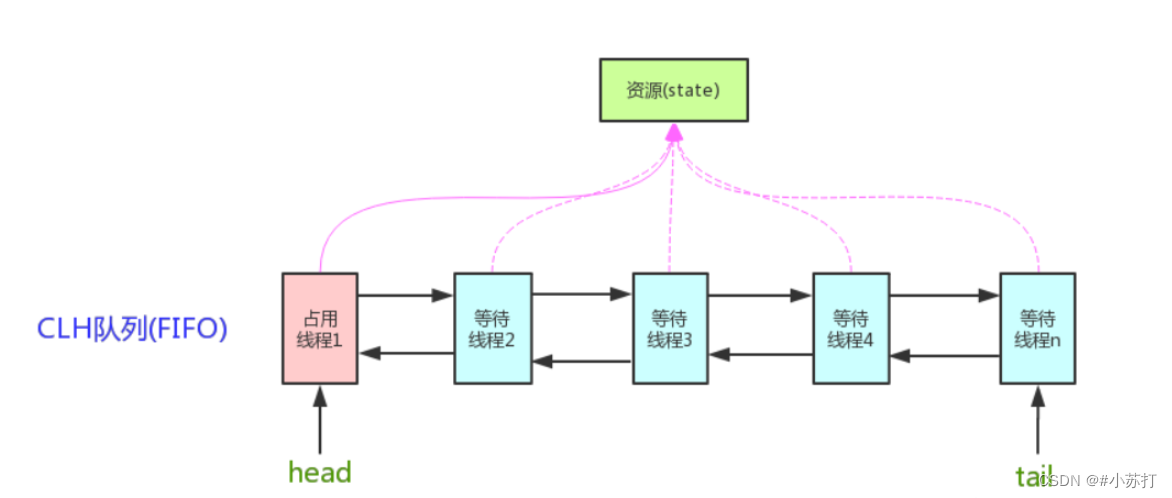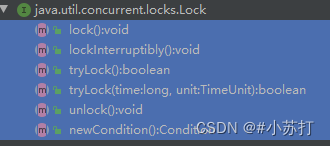Java AQS实现自定义锁
#小苏打 人气:0什么是AQS
AQS(AbstractQueuedSynchronizer),中文名抽象队列同步器
AQS定义了一套多线程访问共享资源的同步器框架,主要用来自定义锁和同步器
AQS原理
AQS 核心思想:
- 如果被请求的共享资源空闲,则将当前请求资源的线程设置为有效的工作线程,并且将共享资源设置为锁定状态。
- 如果被请求的共享资源被占用,将暂时获取不到锁的线程加入到阻塞队列中,等待被唤醒和锁的分配
实现核心思想的的队列:CLH队列
CLH队列是一个虚拟的双向队列,AQS 是将每条请求共享资源的线程封装成一个 CLH 锁队列的一个结点(Node)来实现锁的分配。

共享资源用 volatile 关键词修饰,保证线程间的可见性
/**
* The synchronization state.
*/
private volatile int state;0状态表示空闲,1状态或以上表示不空闲
共享资源(state)的访问方式有三种:
- getState() 获得共享资源状态
- setState() 设置共享资源状态
- compareAndSetState() 更改共享资源状态(底层unsafe类)
源代码如下
/**
* Returns the current value of synchronization state.
* This operation has memory semantics of a {@code volatile} read.
* @return current state value
*/
protected final int getState() {
return state;
}
/**
* Sets the value of synchronization state.
* This operation has memory semantics of a {@code volatile} write.
* @param newState the new state value
*/
protected final void setState(int newState) {
state = newState;
}
/**
* Atomically sets synchronization state to the given updated
* value if the current state value equals the expected value.
* This operation has memory semantics of a {@code volatile} read
* and write.
*
* @param expect the expected value
* @param update the new value
* @return {@code true} if successful. False return indicates that the actual
* value was not equal to the expected value.
*/
protected final boolean compareAndSetState(int expect, int update) {
// See below for intrinsics setup to support this
return unsafe.compareAndSwapInt(this, stateOffset, expect, update);
}利用AQS实现自定义锁
一:首先创建一个类实现Lock接口,它有6个方法需要实现

- lock():加锁(不成功进入阻塞队列等待)
- lockInterruptibly():是否加锁可打断
- tryLock()://加锁(不成功不会进入阻塞队列等待,可以去做其他事情)
- tryLock(long time,TimeUnit unit):加锁(规定时间内未获得则放弃加锁)
- unlock():释放锁
- newCondition():创建条件变量
二:创建一个内部类,继承AbstractQueuedSynchronizer
可以根据需求重写具体方法,总共有5种方法
- isHeldExclusively():该线程是否正在独占资源。只有用到condition才需要去实现它。
- tryAcquire(int):独占方式。尝试获取资源,成功则返回true,失败则返回false。
- tryRelease(int):独占方式。尝试释放资源,成功则返回true,失败则返回false。
- tryAcquireShared(int):共享方式。尝试获取资源。负数表示失败;0表示成功,但没有剩余可用资源;正数表示成功,且有剩余资源。
- tryReleaseShared(int):共享方式。尝试释放资源,如果释放后允许唤醒后续等待结点返回true,否则返回false。
三:我需要自定义一个独占锁,不可重入,具有变量条件的锁
分析
- 独占锁:AQS同步器中需要重写独占方式的获取资源tryAcquire(int)和释放资源tryRelease(int)方法
- 不可重入:AQS同步器需要实现isHeldExclusively():
- 具有条件变量:AQS同步器中 return new ConditionObject();
具体代码如下
//自定义锁(不可重入)(独占锁)(条件变量)
class MyLock implements Lock{
//内部类,AQS同步器类
class MySync extends AbstractQueuedSynchronizer{
@Override
protected boolean tryAcquire(int arg) {
if (compareAndSetState(0,1)){
System.out.println("获得锁成功");
//加上了锁,并设置owner为当前线程
setExclusiveOwnerThread(Thread.currentThread());
return true;
}
System.out.println("获得锁失败");
return false;
}
@Override
protected boolean tryRelease(int arg) {
setExclusiveOwnerThread(null);
setState(0);
return true;
}
@Override
protected boolean isHeldExclusively() {
return getState() == 1;
}
public Condition newCondition(){
return new ConditionObject();
}
}
private MySync mySync = new MySync();
@Override //加锁(不成功进入阻塞队列等待)
public void lock() {
mySync.acquire(1);
}
@Override //加锁可打断
public void lockInterruptibly() throws InterruptedException {
mySync.acquireInterruptibly(1);
}
@Override //加锁(不成功不会进入阻塞队列等待,可以去做其他事情)
public boolean tryLock() {
return mySync.tryAcquire(1);
}
@Override //尝试加锁 带时间
public boolean tryLock(long time, TimeUnit unit) throws InterruptedException {
return mySync.tryAcquireNanos(1,unit.toNanos(time));
}
@Override //释放锁
public void unlock() {
mySync.release(1);
}
@Override //创建条件变量
public Condition newCondition() {
return mySync.newCondition();
}
}加载全部内容